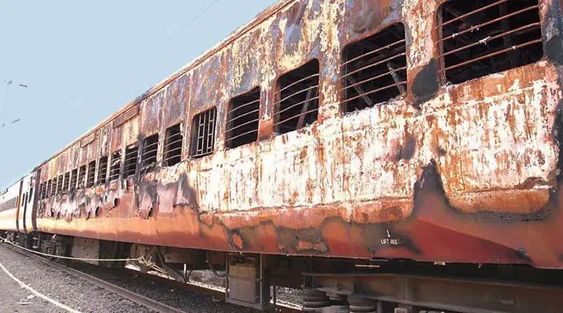‘Accident Or Conspiracy—Godhra’ directed by MK Shivaaksh a movie which opened the eyes of many by unveiling the story of Godhra and the tragedy. After having a controversial phase this movie came to light, the movie talks about one of the most horrific riots in Indian history, which surprised everyone.
In 2023, The Supreme Court granted bail to eight men convicted in the 2002 Godhra train burning case in which 59 people were burnt to death when the S-6 coach of the Sabarmati Express was set on fire by a mob. Four other convicts were denied bail. A total of 31 convicts were sentenced by the trial court in 2011 — 11 were sentenced to death and 20 to life imprisonment. In 2017, the Gujarat High Court commuted the death sentence to life terms — all 31 got life imprisonment. In May 2022, the Supreme Court granted interim bail to Abdul Rahman Dhantiya on medical grounds to attend to his wife, and mentally challenged daughters. In December 2022, it also granted bail to another convict who had spent 17 years in jail.
What is the Sabarmati Express Case-Godhra?
Exactly 22 years ago, Godhra was a non-descript municipal town in Panchmahal district of Gujarat which was known as the land of cows and for Garba. Some religious people belonging to the Vaishnava sect paid pilgrimages to this town which boasts of having a literacy rate above the national average. But the unexpected condition that happened on February 27, 2002, will blow your mind, Godhra attained a new identity, for outsiders and is remembered for a train fire tragedy that killed 59 people and led to communal riots across Gujarat.
At quarter-to-eight in the morning on that early day in 2002, the Sabarmati Express train had scheduled arrival at Godhra railway station. Sabarmati Express then connected Muzaffarpur in Bihar with Ahmedabad in Gujarat and passed through several towns including Ayodhya in Uttar Pradesh. Hundreds of karsevaks (volunteers) had gone to Ayodhya to take part in Purnahuti Yajna organised by Vishva Hindu Parishad (VHP) that had led the Ram Temple movement during the 1980s and early 1990s which resulted in the demolition of Mughal era Babri Mosque in December 1992. On February 25, around 1,700 people – including pilgrims and karsevaks – boarded the Ahmedabad-bound Sabarmati Express, which arrived at Godhra on the morning of February 27.
FROM GODHRA FIRE TO GUJARAT RIOTS
As the train started to leave Godhra railway station, the driver said in his statement, that emergency chains were pulled a few times forcing a stop at the outer signal. According to police, a mob of around 2,000 attacked the train, pelted stones on the bogies and set four coaches on fire. Fifty-nine people including 27 women and 10 children died while 48 others were injured. Coach number S-6 bore the brunt of the attack.
Following the Godhra fire tragedy, riots broke out across Gujarat the next day, February 28. Though the state government claimed to bring the situation under control in three days, the rioting continued for two to three months in the state. As for the number of deaths in post-Godhra riots, the government told the Rajya Sabha in 2005 that 1044 people – 790 Muslims and 254 Hindus – lost them in Gujarat. Another 223 people were reported missing. Twenty-four Muslims and 13 Hindus were killed in police firings. Civil rights activists and NGOs, however, put the figure of those killed in the 2002 communal riots in Gujarat at over 2,000.
Action Taken by Government
The state government constituted a commission of enquiry headed by Justice GT Nanavati with Justice KG Shah as a member. The commission submitted its report saying that most of those killed were karsevaks and pilgrims returning from Ayodhya.
Meanwhile, another report by the Forensic Studies Laboratory (FSL) at Gandhinagar, Gujarat prepared by Mohinder Singh Dahiya, the then assistant director at the FSL, concluded that coach-6 was set on fire from within. The FSL report concluded that someone standing at seat number 72 opened a container with a big mouth to pour liquid fuel to set the coach on fire. The report argued that it could be an insider’s handiwork.
TRIAL AND CONVICTIONS
The trial began in June 2009 – seven years after the Godhra train burning incident. Two years later, a fast-track court in Ahmedabad convicted 31 persons while acquitting 63 other accused in the case. The trial court came to the same conclusion arrived at by the Nanavati Commission that the Godhra train burning was not an unplanned mob outrage rather it was a conspiracy. Of those convicted for the Godhra train burning, 11 were sentenced to death while 20 others were handed life imprisonment. In October last year, the Gujarat High Court commuted the death sentences of 11 convicts to life term while upholding others’ quantum of sentence and acquittal in the case. So, now all 31 convicts of the Godhra train burning incident are sentenced to life.
Decode Politics: Modi raises a report on 2002 Godhra train burning to attack Lalu, Congress.
While addressing an election rally in Bihar’s Darbhanga on May 4, Prime Minister Narendra Modi referred to the Justice U C Banerjee Commission that had probed the Godhra train burning incident of 2002.The PM said the then Railway Minister (Lalu Prasad) “acted in connivance with the Congress”, which headed the UPA-1 government at the Centre, to set free the accused in the train burning.
Without mentioning Lalu by name, Modi said: “When the kar sevaks were burnt alive in Godhra, the Railway Minister (Lalu Prasad) was the father of this shehzade (in an apparent reference to Tejashwi Yadav)… To save the accused, he appointed a committee headed by a Supreme Court judge… Its name was Ben-raji committee (the PM twisted the name, Banerjee, apparently to indicate it was a compliant panel). Soniaben ka raaj tha… aur isiliye unhone Ben-raji committee banayi (It was the rule of Sonia Gandhi… and that is why they set up the Ben-raji committee)… They got a report written through him (Banerjee) declaring that those who burnt alive the 60 kar sevaks were innocent and should be set free.”
What was the Banerjee Committee?
In 2004, the Ministry of Railways, then under Lalu, set up a high-level committee under retired Supreme Court Justice Umesh Chandra Banerjee to investigate the fire. The committee was set up under Section 114 of the Railways Act 1989, which mandates an inquiry into a train accident “resulting in loss of human life or grievous hurt”. The panel’s terms of reference were to ascertain the cause of the fire, and to look into the events after the train left Muzaffarpur on February 25, 2002, and till it reached Godhra through the states of Bihar, Uttar Pradesh and Madhya Pradesh. The inquiry was to also ascertain acts of omission and commission. On January 17, 2005, the committee submitted an interim report concluding that the fire was “accidental” and not a “deliberate attempted event”.






























